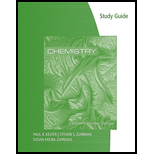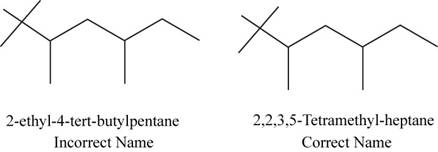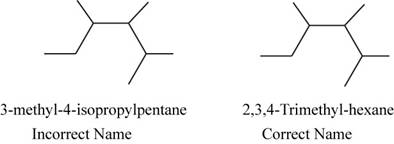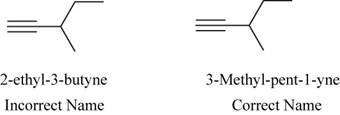
Concept explainers
(a)
Interpretation: The following incorrectly named compounds are to be drawn and named correctly.
Concept introduction: Organic compounds contain carbon and hydrogen atoms with their respective
To determine: The correct name of the given compound and its structure is to be drawn.
(a)
Answer to Problem 121AE
Answer
The correct name of the compound is
Explanation of Solution
Explanation
The correct name of the compound is
The structure of

Figure 1
The root name hexane signifies the presence of six carbon atoms.
(b)
Interpretation: The following incorrectly named compounds are to be drawn and named correctly.
Concept introduction: Organic compounds contain carbon and hydrogen atoms with their respective functional groups. When they are named the root term, suffix and prefix are to be remembered. They are named according to the International Union of Pure and Applied Chemistry
To determine: The correct name of the given compound and its structure is to be drawn.
(b)
Answer to Problem 121AE
Answer
The correct name of the compound is
Explanation of Solution
Explanation
The correct name of the compound is
The structure of

Figure 2
The root name is pentane which signifies the presence of five carbon atoms in a chain,
(c)
Interpretation: The following incorrectly named compounds are to be drawn and named correctly.
Concept introduction: Organic compounds contain carbon and hydrogen atoms with their respective functional groups. When they are named the root term, suffix and prefix are to be remembered. They are named according to the International Union of Pure and Applied Chemistry
To determine: The correct name of the given compound and its structure is to be drawn.
(c)
Answer to Problem 121AE
Answer
The correct name of the compound is
Explanation of Solution
Explanation
The correct name of the compound is
The structure of 3-methyl 4-isopropylpentane with its correct name is,

Figure 3
The root name pentane signifies the presence of five carbon atoms in a chain and
(d)
Interpretation: The following incorrectly named compounds are to be drawn and named correctly.
Concept introduction: Organic compounds contain carbon and hydrogen atoms with their respective functional groups. When they are named the root term, suffix and prefix are to be remembered. They are named according to the International Union of Pure and Applied Chemistry
To determine: The correct name of the given compound and its structure is to be drawn.
(d)
Answer to Problem 121AE
Answer
The correct name of the compound is
Explanation of Solution
Explanation
The correct name of the compound is
The structure of

Figure 4
The root name butyne signifies the presence of four carbon atoms with a triple bond in a chain and
Want to see more full solutions like this?
Chapter 22 Solutions
Study Guide for Zumdahl/Zumdahl/DeCoste’s Chemistry, 10th Edition
- Write the systematic name of each organic molecule: structure HO-C-CH2-CH3 O -OH CH3-CH2-CH2-CH2-CH2-C-OH CH3 CH3-CH-CH2-C-OH Explanation Check S namearrow_forwardtheres 2 productsarrow_forwardDraw the major product of this solvolysis reaction. Ignore any inorganic byproducts. + CH3CH2OH Drawing Q Atoms, Bonds and Rings OCH2CH3 || OEt Charges OH 00-> | Undo Reset | Br Remove Done Drag To Pan +arrow_forward
- Draw the major product of this SN1 reaction. Ignore any inorganic byproducts. CH3CO2Na CH3CO2H Drawing + Br Q Atoms, Bonds and Rings OAC Charges OH ОАс Na ဂ Br Undo Reset Remove Done Drag To Pan +arrow_forwardOrganic Functional Groups entifying positions labeled with Greek letters in acids and derivatives 1/5 ssible, replace an H atom on the a carbon of the molecule in the drawing area with a ce an H atom on the ẞ carbon with a hydroxyl group substituent. ne of the substituents can't be added for any reason, just don't add it. If neither substi er the drawing area. O H OH Oneither substituent can be added. Check D 1 Accessibility ado na witharrow_forwardDifferentiate between electrophilic and nucleophilic groups. Give examples.arrow_forward
- An aldehyde/ketone plus an alcohol gives a hemiacetal, and an excess of alcohol gives an acetal. The reaction is an equilibrium; in aldehydes, it's shifted to the right and in ketones, to the left. Explain.arrow_forwardDraw a Haworth projection or a common cyclic form of this monosaccharide: H- -OH H- OH H- -OH CH₂OHarrow_forwardAnswer the question in the first photoarrow_forward
- Ggggffg2258555426855 please don't use AI Calculate the positions at which the probability of a particle in a one-dimensional box is maximum if the particle is in the fifth energy level and in the eighth energy level.arrow_forwardExplain the concepts of hemiacetal and acetal.arrow_forwardBriefly describe a nucleophilic addition.arrow_forward
 World of Chemistry, 3rd editionChemistryISBN:9781133109655Author:Steven S. Zumdahl, Susan L. Zumdahl, Donald J. DeCostePublisher:Brooks / Cole / Cengage Learning
World of Chemistry, 3rd editionChemistryISBN:9781133109655Author:Steven S. Zumdahl, Susan L. Zumdahl, Donald J. DeCostePublisher:Brooks / Cole / Cengage Learning
 Chemistry for Today: General, Organic, and Bioche...ChemistryISBN:9781305960060Author:Spencer L. Seager, Michael R. Slabaugh, Maren S. HansenPublisher:Cengage Learning
Chemistry for Today: General, Organic, and Bioche...ChemistryISBN:9781305960060Author:Spencer L. Seager, Michael R. Slabaugh, Maren S. HansenPublisher:Cengage Learning Chemistry: An Atoms First ApproachChemistryISBN:9781305079243Author:Steven S. Zumdahl, Susan A. ZumdahlPublisher:Cengage Learning
Chemistry: An Atoms First ApproachChemistryISBN:9781305079243Author:Steven S. Zumdahl, Susan A. ZumdahlPublisher:Cengage Learning Introductory Chemistry: An Active Learning Approa...ChemistryISBN:9781305079250Author:Mark S. Cracolice, Ed PetersPublisher:Cengage Learning
Introductory Chemistry: An Active Learning Approa...ChemistryISBN:9781305079250Author:Mark S. Cracolice, Ed PetersPublisher:Cengage Learning World of ChemistryChemistryISBN:9780618562763Author:Steven S. ZumdahlPublisher:Houghton Mifflin College Div
World of ChemistryChemistryISBN:9780618562763Author:Steven S. ZumdahlPublisher:Houghton Mifflin College Div





